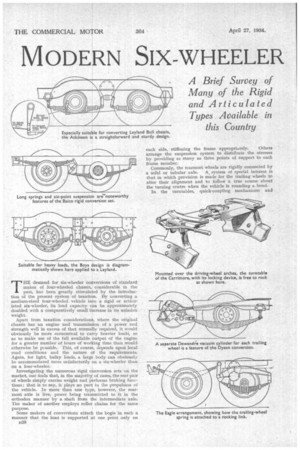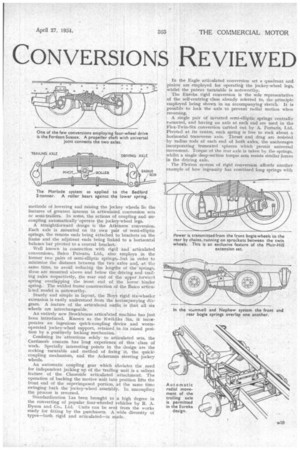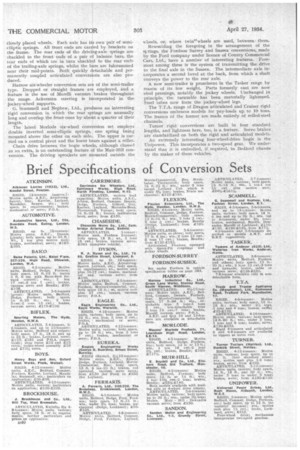MODERN SIX-WHEELER CONVERSIONS REVIEWED
Page 104

Page 105

Page 106

If you've noticed an error in this article please click here to report it so we can fix it.
THE demand for six-wheeler conversions of standard makes of foun-wheeled chassis, considerable in the past, has been greatly stimulated by the introduction of the present system of taxation. By converting a medium-sized four-wheeled vehicle into a rigid or articu-fated six-wheeler, its load capacity can be approximately doubled with a comparatively small increase in its unladen weight.
Apart from taxation considerations, where the original chassis has an engine and transmission of a power and strength well in excess of that normally required, it would obviously be more economical to carry heavier loads, so as to make use of the full available output of the engine for a greater number of hours of working time than would otherwise be possible. This, of course, depends upon local road conditions and the nature of the requirements. Again, for light, bulky loads, a large body can obviously be accommodated more satisfactorily on a six-wheeler than on a four-wheeler.
Investigating the numerous rigid conversion sets on the market, one finds that, in the majority of cases, the rear pair of wheels simply carries weight and performs braking functions ; that is to say, it plays no part in the propulsion of the vehicle. In more than one type, however, the rearmost axle is live, power being transmitted to it in the orthodox manner by a shaft from the intermediate axle. The maker of another employs roller chains for the same purpose.
Some makers of conversions attach the bogie in such a manner that the loan is supported at one point only on n38 methods of lowering and raising the jockey wheels lie the features of greatest interest in articulated conversion sets or semi-trailers. In some, the actions of coupling and uncoupling automatically 'operate the jockey-wheel legs.
A straightforward design is the Atkinson conversion. Each axle is mounted on its own pair of semi-elliptic springs, the remote ends being attached to brackets on the frame and the adjaCent ends being linked to a horizontal balance bar pivoted to a central bracket Well known in connection with rigid and articulated conversions, Baico Patents Ltd., also employs in the former two pairs of semi-elliptic springs, but in order to minimize the distance between the two axles and, at the same time, to avoid reducing the lengths of the 'springs, these are mounted above and below the driving and trailing axles respectively, the rear end• of the upper forward spring overlapping the front end of the lower hinder spring. The welded frame construction Of the Baico articulated model is noteworthy.
Sturdy and simple in layout, the Boys rigid six-wheeler extension is easily understood from the accompanying diagram. A feature of the articulated outfit is that all six wheels are interchangeable.
An entirely new Brockhouse articulated machine has just been introduced. Known as the Kwil:fiks Six, it incorporates an ingenious quick-coupling device and wormoperated jockey-wheel support, retained in its raised position by a positively locking mechanism.
Confining its attentions solely to articulated sets, the Carrimoie concern has long experience, of this class of work. Specially interesting points in the design are the reeking turntable and method of fixing it, the quick coupling mechanism, and the Ackerman steering jockey wheels.
An automatic coupling gear which obviates the .need for independent jacking up of the trailing unit is a salient feature of the Chaseside articulated attachment. The operation of backing the motive unit into position lifts the front end of the superimposed portion, at the same time swinging back the jockey-wheel assembly. In uncoupling the process is reversed.
Standardization Las been brought to a high degree in the converting of popular four-wheeled vehicles by R. A. Dyson and Co., Ltd. Units can be sent from the works ready for fitting by the purchasers. A wide diversity of types—both rigid and articulated—is made.
In the Eagle articulated conversion set a quadrant and pinion are employed for operatink the jockey-wheel legs, whilst the patent turntable is noteworthy.
The Eureka rigid conversion is the sole representative of the self-centring class already referred to, the principle employed being shown in an accompanying sketch. It is possible to lock the axle to prevent radial motion when L,
reversing.
A single pair of inverted semi-elliptic springs centrally munted, and having an axle at each end are used in the Flex-Twin-Six conversion carried out by A. Ferraris, Ltd. Pivoted at its centre, each spring is free to reek about a horizontal transverse axis, Thrust and drag are resisted y radius rods at each end of both axles, the anchorages incorporating truncated spheres which permit universal movement. Torque of the rear axle is taken by the springs, whilst a single deep-section torque arm resists similar forces in the driving axle.
The Flexion system of rigid conversion affords another example of how ingenuity has combined long springs with closely placed wheels. Each axle has its own pair of semi• elliptic springs. All front ends are carried by brackets on the frame. The rear ends of the driving-axle springs are shackled to the front ends of a pair of balance bars, the rear ends of which are in turn shackled to the rear ends of the trailing-axle springs, whilst the bars are fulcrummed near their mid-points. Both quickly detachable and permanently coupled articulated conversions are also produced.
Harrow six-wheeler conversion sets are of the semi-trailer type. Dropped or straight frames are employed, and a feature is the use of MareIli vacuum brakes throughout the range. Ackerman steering is incorporated in the jockey-wheel supports. G. Scammell and Nephew, Ltd., produces an interesting rigid conversion in which the rear springs are unusually long and overlap the front ones by about a quarter of their length.
The latest Morlode six-wheel conversion set employs double inverted semi-elliptic springs, one spring being mounted above the other on each side. The upper is carried on a central pivot and the lower bears against a roller.
Chain drive between the bogie wheels, although classed as an extra, is an outstanding feature of the Muir-Hill conversion. The driving sprockets are mounted outside the
vs heels, or, where twin"rwheeis are used, betweenthem.
Resembling the foregoing in the arrangement of the si:rings, the Fordson Surrey and Sussex conversions, made by the Ford company under licence of County Commercial Cars, Ltd., have a number of interesting features. Foremost among these is the system of transmitting the drive to the final axle in the Sussex. The intermediate axle incorporates a second bevel at the back, from which a shaft conveys the power to the rear axle.
A new semi-trailer is prominent in the Tasker range by reason of its low weight. Parts formerly cast are now steel pressings, notably the jockey wheels. Unchanged in principle, the turntable has been materially lightened. Steel tubes now form the jockey-wheel legs.
The T.T.A. range of Dragon articulated and Cruiser rigid conversions embraces models for pay-loads up to 10 tons. The frames of the former are made entirely of rolled-steel channels.
Turner rigid conversions are built in four standard lengths, and lightness here, too, is a feature. Servo brakes are standardized on both the rigid and articulated models.
An extremely interesting four-wheel-drive bogie is the linipower. This incorporates a two-speed gear. We understand that it is embodied, if required, in Bedford chassis by the maker of these vehicles.




















































































































































































